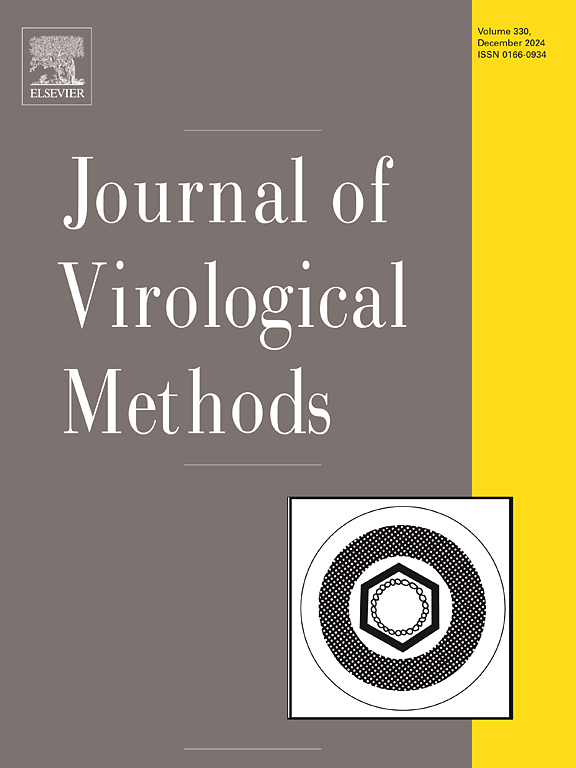一种基于平板阅读器的抗体依赖增强(ADE)检测正黄病毒感染的新方法的建立
IF 1.6
4区 医学
Q3 BIOCHEMICAL RESEARCH METHODS
引用次数: 0
摘要
抗体依赖性增强(ADE)是与某些病毒(包括登革热病毒(DENV))引起的感染的严重临床结果相关的机制之一。已经建立了几种ADE检测系统,包括使用活病毒的流式细胞术检测,用于检测病毒NS1的酶联免疫吸附试验(ELISA)和荧光素酶报告基因检测。其中,流式细胞术是评价ADE活性最常用的方法;然而,它有局限性,如固定和免疫染色程序的操作成本高,以及分析时间长。表达荧光蛋白的单轮感染性颗粒(srip)可以实现ADE活性的无标记检测,但流式细胞术仍然需要很长的分析时间。在本研究中,为了简化和加快使用增强的绿色荧光蛋白(EGFP)表达的条带进行ADE检测,我们开发了一种基于平板阅读器的ADE检测方法,作为传统的基于流式细胞术的方法的替代方法。为了评估该方法的有效性,我们使用活病毒流式细胞术和基于板读器表达egfp的SRIPs法检测了泛正黄病毒4G2和泛登革热4E11单克隆抗体(mab)诱导的K562细胞中的ADE活性。结果显示,两种不同的ADE检测结果之间具有很强的相关性,4G2 mAb的R²值为0.92,4E11 mAb的R²值为0.94 (Pearson相关系数)。总之,这种新建立的检测方法为全面表征疫苗或感染诱导抗体与正黄病毒感染ADE之间的关系提供了一种高通量和高成本效益的方法。本文章由计算机程序翻译,如有差异,请以英文原文为准。
Development of a novel plate reader-based antibody-dependent enhancement (ADE) assay for orthoflavivirus infections
Antibody-dependent enhancement (ADE) is one of the mechanisms associated with severe clinical outcomes in infections caused by certain viruses, including dengue virus (DENV). Several ADE assay systems have been established, including flow cytometric assays using live viruses, enzyme-linked immuno-sorbent assay (ELISA) for the detection of viral NS1, and luciferase reporter gene assays. Among these, the flow cytometric assay is the most commonly used to evaluate ADE activity; however, it has limitations such as high operational costs due to fixation and immunostaining procedures, as well as a long analysis time. Fluorescent protein-expressing single-round infectious particles (SRIPs) enables label-free detection of ADE activity, but the flow cytometric procedure still requires a long analysis time. In this study, to simplify and expedite the ADE assay using enhanced green fluorescent protein (EGFP)-expressing SRIPs, we developed a plate reader-based ADE assay as an alternative to the conventional flow cytometry-based method. To evaluate effectiveness of this assay, we measured ADE activities in K562 cells induced by pan-orthoflavivirus 4G2 and pan-dengue 4E11 monoclonal antibodies (mAbs) using both flow cytometric assays using live viruses and plate-reader-based EGFP-expressing SRIPs assays. The results showed strong correlations between the two different ADE assays with R² values of 0.92 for 4G2 mAb and 0.94 for 4E11 mAb (Pearson correlation coefficients). In summary, this newly established assay offers a high-throughput and cost-effective method for comprehensive characterization of the relationship between vaccine- or infection-induced antibodies and ADE in orthoflavivirus infections.
求助全文
通过发布文献求助,成功后即可免费获取论文全文。
去求助
来源期刊
CiteScore
5.80
自引率
0.00%
发文量
209
审稿时长
41 days
期刊介绍:
The Journal of Virological Methods focuses on original, high quality research papers that describe novel and comprehensively tested methods which enhance human, animal, plant, bacterial or environmental virology and prions research and discovery.
The methods may include, but not limited to, the study of:
Viral components and morphology-
Virus isolation, propagation and development of viral vectors-
Viral pathogenesis, oncogenesis, vaccines and antivirals-
Virus replication, host-pathogen interactions and responses-
Virus transmission, prevention, control and treatment-
Viral metagenomics and virome-
Virus ecology, adaption and evolution-
Applied virology such as nanotechnology-
Viral diagnosis with novelty and comprehensive evaluation.
We seek articles, systematic reviews, meta-analyses and laboratory protocols that include comprehensive technical details with statistical confirmations that provide validations against current best practice, international standards or quality assurance programs and which advance knowledge in virology leading to improved medical, veterinary or agricultural practices and management.

 求助内容:
求助内容: 应助结果提醒方式:
应助结果提醒方式:


